IJCRR - 3(4), April, 2011
Pages: 46-52
Print Article
Download XML Download PDF
IMPACT OF ICT IMPLEMENTATAION IN SECONDARY SCHOOLS: A CASE STUDY OF SCHOOLS IN KARAD OF SATARA DISTRICT
Author: R.D. Kumbhar, Abhijit S. Desai, Hanmant N. Renushe, Prasanna R. Rasal
Category: Healthcare
Abstract:This research paper sets with the objective to study the impact of Information and
Communication Technology (ICT) implementation in selected secondary schools in karad city The scope of the study is confined to the teaching learning process of a secondary school. As a
part of research design, secondary schools are selected based on a stratified random sampling method. A review of literature has taken to study the present status of research studies in the area of ICT implementation in schools. Review of literature has helped to decide various key performance indicators; on that basis the impact of ICT implementation can be studied. Data collection has been carried out by questionnaire and interview schedule methods from important key stakeholders such as students and teachers. The collected data was analyzed using
appropriate analysis tools and hypothesis was tested. It was found that the performance of students is enhanced after ICT implementation in teaching learning process. It has found that there is improvement in the effectiveness of teaching learning process of secondary schools.
Keywords: ICT, school, teaching stakeholders, performance.
Full Text:
INTRODUCTION
Education system always runs with the objective of providing knowledge to learners by all possible ways using all types of mediums available. Information and Communication Technology has the potential to play a vital role in every university‘s teaching - learning process. Implementation of ICT has an impact on some key areas such: redesign and presentation of curriculum, uses of available resources and the way current activities of teaching-learning process are being reconfigured. This study undertaken with the aim of conducting qualitative research study and was carried out in selected secondary schools in karad city to assess impact of implementation of Information and communication technologies on teachinglearning process. There are a variety of philosophical approaches to the integration of ICT. It is also recognized that rapid technological advancements will inevitably -age? traditional observations in educational delivery of curriculum and classroom design.[1]
INFORMATION AND COMMUNICATION TECHNOLOGY (ICT):
Information and communications technologies (ICT) are a diverse set of technological tools and resources used to communicate, and to create, disseminate, store, and manage information. Communication and information are at the very heart of the educational process, consequently ICT-use in education has a long history. ICT has played an educational role in formal and non-formal settings, in programs provided by governmental agencies, public and private educational institutions, for-profit corporations and nonprofit groups, and secular and religious communities. [2] The new digital ICTs are combinations of hardware, software, media, and delivery systems. Today, ICT in education encompasses a great range of rapidly evolving technologies such as desktop, notebook, and handheld computers, digital cameras, local area networking, the Internet2 and the World Wide Web, CDROMs and DVDs; and applications such as word processors, spreadsheets, tutorials, simulations, electronic mail (email), digital libraries, computer-mediated conferencing, videoconferencing, and virtual reality. The advantages of ICT implementation in education are integration of multiple media, interactivity, usage flexibility, better connectivity, new pedagogical methods, remote resource access, enabling collaborations amongst online experts to deliver best possible knowledge to learners, etc. There are some difficulties faced in implementing such innovations, and due to rapid evolution in technologies, the present technology used for ICT implementation in education may quickly become outdated.[3]
SIGNIFICANCE OF THE STUDY
A major purpose of this research is to build up specific knowledge about conditions and problems of accomplishment of ICT implementation, to reach conclusions about how ICT implementation can best be accomplished, and to establish a framework for ICT implementation in university‘s teaching-learning process. This research is also to obtain a clearer understanding of the practical needs and challenges of ICT implementation in a school and to support the development of higher level ICT implementation and development in general in India. The present study shows practices in the teaching learning process of a school have implemented ICT applications effectively. However the feedback from the students reveals the actual impact and effectiveness of ICT implementation. There is immense need to study what are the barriers for successful implementation of ICT. There is also need to study various methodologies used for ICT implementation.
OBJECTIVES OF THE STUDY
This study sets out the following objectives: 1. To review usage of ICT implementation by students to support their learning process. 2. To assess the students attitudes toward Information and Communication Technology.
RESEARCH DESIGN The research study can be divided into two main parts: the first part involved the research questions that attempt to assess the impact of use of ICT implementation on teaching learning process oof a school and familiarity of the students.
The second part of the research study, examines the possible relationship between the use of ICTs and the gender as well as the students performance.
SAMPLING
The sample of the research was chosen from the students in various secondary schools in karad city. The research sample of size 130 was selected from 650 students (the overall number of class X students) from 18 secondary schools in karad city on the basis of random sampling method and a questionnaire was distributed to them in order to complete it. The questionnaire was divided into two main areas. The first part of the questionnaire focuses on the student‘s experience of using ICT. This area attempted to examine whether the respondents have internet access in school lab, whether they use e-mail, other internet tools and whether they can use social networking to support their studies. The second of the questionnaire helps to derive information about students‘ attitudes to computer use and knowledge. For the purpose of data analysis, descriptive statistics methods were used.
FINDINGS AND SUGGESTIONS
According to the findings of the research, some of the findings regarding the students experience of using ICT and students attitudes towards use of computers and knowledge. The details of analysis shown in appendix-I
- 67 % students use ICT implementation to obtain information for their studies
- 78 % students visit school lab very frequently.
- 78 % students prefer ICT implementation in learning activities.
- 88 % students prefer not to use computers to support the study.
- 17 % students prefer to use ICT implementation for a module instead of a lecture
- 75 % students use computer as a support to other teaching activities.
- 79 % students like to communicate with teacher using emails.
- 94 % student‘s percentage of marks increased after implementation of ICT.
- 91 % student‘s attendance increase after use of ICT.
CONCLUSION
This study found that students of secondary schools in Karad city were generally favorable to ICTs implementation in teaching learning process. About students‘ performance, the survey revealed that students that use computers more often tend to score higher than other students. Based on the findings of the research it is recommended for the teachers of schools in karad city to increase motivation level of the students to use ICTs to support their studies. This can be achieved from the by providing adequate and latest facilities to the students to have internet. The teachers should integrate ICTs in their teaching methods/processes and motivate students to use computers by writing assignments or searching the internet for information for their studies. Furthermore, the ICT implementation is very important for the students after finishing their studies. The ICTs knowledge can help students in their future studies as well as in work environments and gives them competitive advantage comparing to others who are not familiar with computers.
ACKNOWLEDGMENT
The researchers are grateful to the authors, writers and editors of the books and articles, which have been referred for preparing the presented research paper. It is the duty of the researchers to remember their parents whose blessings are always with them.
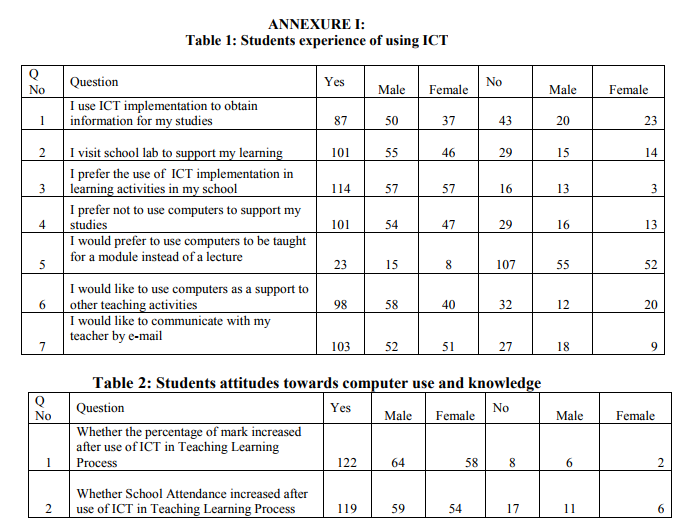


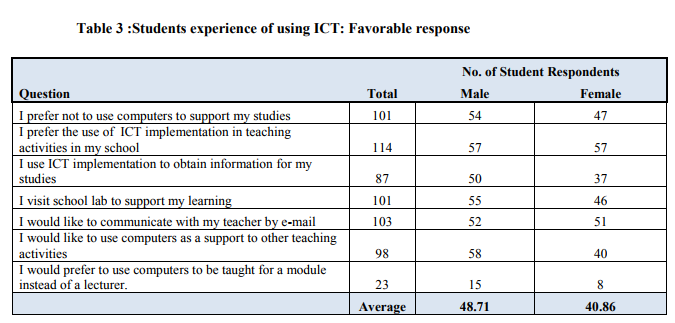
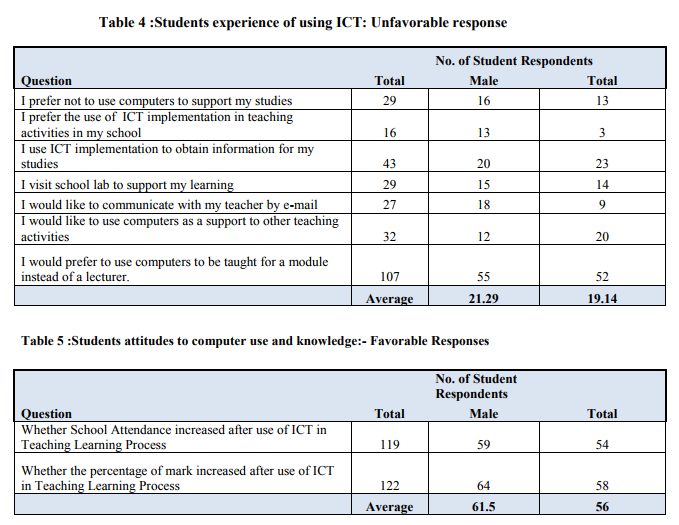

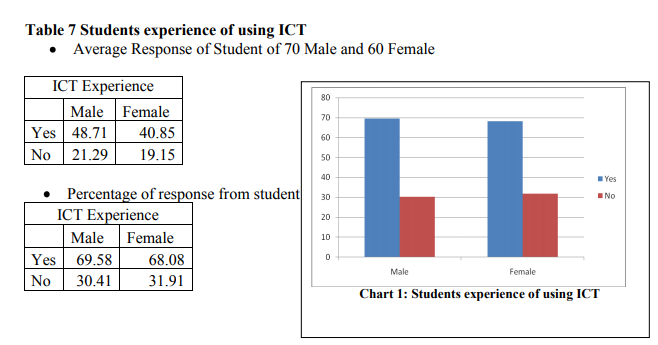
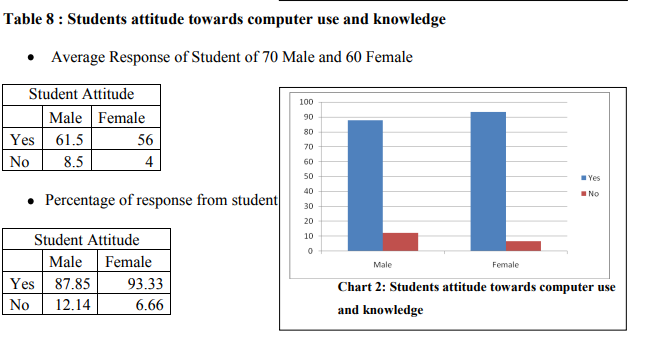
References:
1. Mary Hayes, David Whitebread(1996) ICT in early years?, Tata McGraw hill Education New Delhi, ISBN: 9780335208098
2. Victoria L. Tino(2002) - ICT in Education?, UNDP-APDIP
3. Mary Hayes, David Whitebread(1996) - ICT in early years?, Tata McGraw hill Education New Delhi, ISBN: 9780335208098
4. Prof. c Burton(1999), New Directions of ICT-Use in Education, UNESCO's World communication and Information Report 1999, available at www.unesco.org/education/educprog/lw f/dl/edict.pdf, accessed on 4 June 2010.
5. Asifiwe Collins Gyavira Rubanju (2002), The impact of ICT on Universities: Classroom/Lecture theatre Design and Curriculum Delivery.Available at www.uv.uio.no/... /docs/The%20impact %20of%20 ICT%20on%20Universities.doc , accessed on 31 may 2010.
6. G.S.Vidyashankar and L.Prakash Sai(2006), -ICT-based Education in Schools: Emerging Business Models in India,
7. Areti Valasidou(2008), The Impact Of ICT‘s In Education:The Case Of University of Macedonia Students, Journal of Business Case Studies - March 2008 Volume 4,Number 3, available at www.cluteinstituteonlinejournals.com/PDFs/691.pdf , accessed on 3 June 2010
8. National mission on Education (2009), synopsis of National Mission on Education through ICT, available at http://www.education.nic.in/dl/SYNOPS IS-NME.pdf, accessed on 1st September 2010.
|






 This work is licensed under a Creative Commons Attribution-NonCommercial 4.0 International License
This work is licensed under a Creative Commons Attribution-NonCommercial 4.0 International License